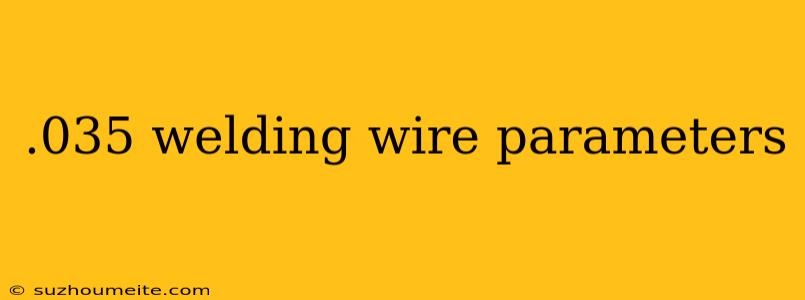.035 Welding Wire Parameters: A Comprehensive Guide
When it comes to welding, having the right equipment and settings is crucial to achieving high-quality results. One of the most important factors to consider is the welding wire, and in particular, the .035 welding wire. In this article, we will delve into the parameters of .035 welding wire and explore its uses, benefits, and limitations.
What is .035 Welding Wire?
.035 welding wire is a type of mild steel welding wire with a diameter of 0.035 inches (0.89 mm). It is a popular choice among welders due to its versatility, ease of use, and affordability. This wire is suitable for a wide range of welding applications, including MIG (GMAW), flux cored arc welding (FCAW), and submerged arc welding (SAW).
Welding Parameters for .035 Welding Wire
Voltage
The voltage required for .035 welding wire depends on the welding process and the type of metal being welded. Here are some general guidelines:
- MIG (GMAW): 18-22 volts
- FCAW: 20-25 volts
- SAW: 25-30 volts
Wire Feed Speed
The wire feed speed for .035 welding wire typically ranges from 100 to 300 inches per minute (IPM). However, the ideal speed will depend on the specific welding application, the thickness of the metal, and the desired weld quality.
Shielding Gas
The shielding gas used with .035 welding wire can vary depending on the welding process and the type of metal being welded. Here are some common shielding gases used with .035 welding wire:
- Argon (Ar)
- Argon-CO2 mixtures (75% Ar, 25% CO2)
- Helium (He)
- Helium-Argon mixtures (90% He, 10% Ar)
Welding Techniques
The welding technique used with .035 welding wire can significantly impact the quality of the weld. Here are some common techniques used with .035 welding wire:
- Push angle: 10-15 degrees
- Travel speed: 10-20 IPM
- Work angle: 10-20 degrees
Benefits of .035 Welding Wire
Versatility
.035 welding wire is suitable for a wide range of welding applications, including automotive, construction, and manufacturing.
Ease of Use
.035 welding wire is relatively easy to use, even for novice welders.
Affordability
.035 welding wire is generally less expensive than thicker welding wires, making it a cost-effective option for many welding applications.
Limitations of .035 Welding Wire
Thickness Limitations
.035 welding wire is best suited for welding thin to medium-thick metals (up to 1/4 inch or 6 mm).
Heat Input
.035 welding wire requires a higher heat input than thicker welding wires, which can lead to burn-through or distortion of the metal.
Porosity
.035 welding wire can be prone to porosity, especially if the welding technique is not proper or if the shielding gas is not adequate.
Conclusion
In conclusion, .035 welding wire is a versatile and widely used welding wire that offers many benefits, including ease of use, affordability, and versatility. However, it also has some limitations, including thickness limitations, high heat input requirements, and porosity. By understanding the parameters of .035 welding wire and following proper welding techniques, welders can achieve high-quality results and maximize the benefits of this popular welding wire.
